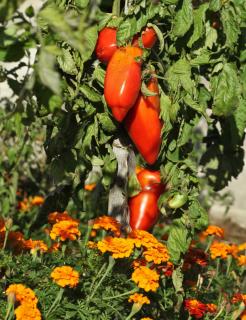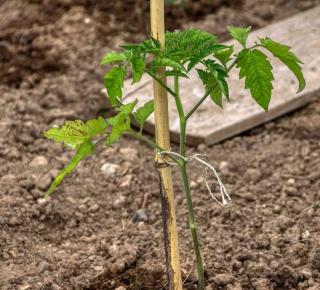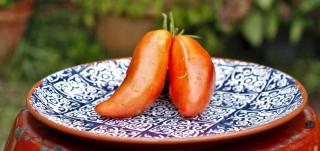

It looks like a large chili, which makes the ‘Andine Cornue’ tomato among the most recognizable.
It has all you’d expect from a tomato that clearly deserves a row in your veggie patch: vigor, productivity, abundant fruits…
 As its name shows, this tomato is native to the Andes mountains of South America. The name is French because a French botanist made it known to the world. The plant also appears under the name ‘Red bull horn’, ‘Horn of the Andes’, ‘Rouge des Andes’ and even ‘Red banana’ tomato. Apart from this unique and uncommon silhouette, this tomato is perhaps the most appealing solanaceae variety of all:
As its name shows, this tomato is native to the Andes mountains of South America. The name is French because a French botanist made it known to the world. The plant also appears under the name ‘Red bull horn’, ‘Horn of the Andes’, ‘Rouge des Andes’ and even ‘Red banana’ tomato. Apart from this unique and uncommon silhouette, this tomato is perhaps the most appealing solanaceae variety of all:
Start your sowing as early as March, but make sure the seedlings are sheltered from freezing. To start them off, proceed as follows:
Once your seedlings have reached a nice size with several new leaves (or if you’ve purchased them), you can transplant them to the growing bed sometime in May, since freezing is unlikely after that. You’ll then have to :
 enrich the topsoil with manure or well-seasoned compost;
enrich the topsoil with manure or well-seasoned compost;Caring for the ‘Andine Cornue’ tomato is, in the end, simply doing what’s needed for water. It must follow a regular schedule but should not be overabundant. Furthermore, to fully eliminate risk of diseases, do what you must to never get the leaves wet.
When fruits begin to appear, start removing a few leaves to let sunlight filter to the forming fruits. The goal of this light defoliation is to help speed fruit ripening. Don’t overdo it, though, because you don’t want to weaken the plant.
As is the case for most tomato varieties, the ‘Andine Cornue’ also is impacted by tomato downy mildew. It may also fall victim to fruit tip necrosis. As for parasites and pests, tomato plants are often targeted by whitefly (tiny white winged insects) and bollworm moth caterpillars.
In the picture near the top of this article, Andean tomato is planted with marigolds together: an excellent example of companion planting.
Depending on when the sowing started, the harvest extends from July to October. The best way to savor it is to simply pick whichever fruits are ripe, whenever you need them. To keep whichever extra fruits you may have harvested, place the tomatoes in the refrigerator for a maximum of 5 to 6 days.
 Whether you’re planning a tossed salad with mozzarella, a nice thick tomato sauce, tomato coulis or a delicious tomato juice, there’s always going to be a great recipe to accommodate your ‘Cornue des Andes’ tomato.
Whether you’re planning a tossed salad with mozzarella, a nice thick tomato sauce, tomato coulis or a delicious tomato juice, there’s always going to be a great recipe to accommodate your ‘Cornue des Andes’ tomato.
To learn more, read: